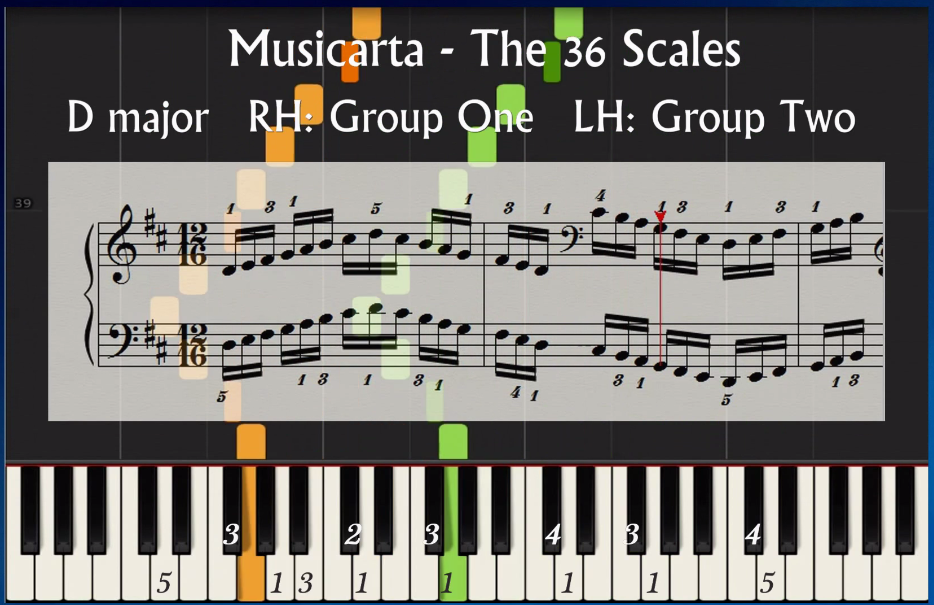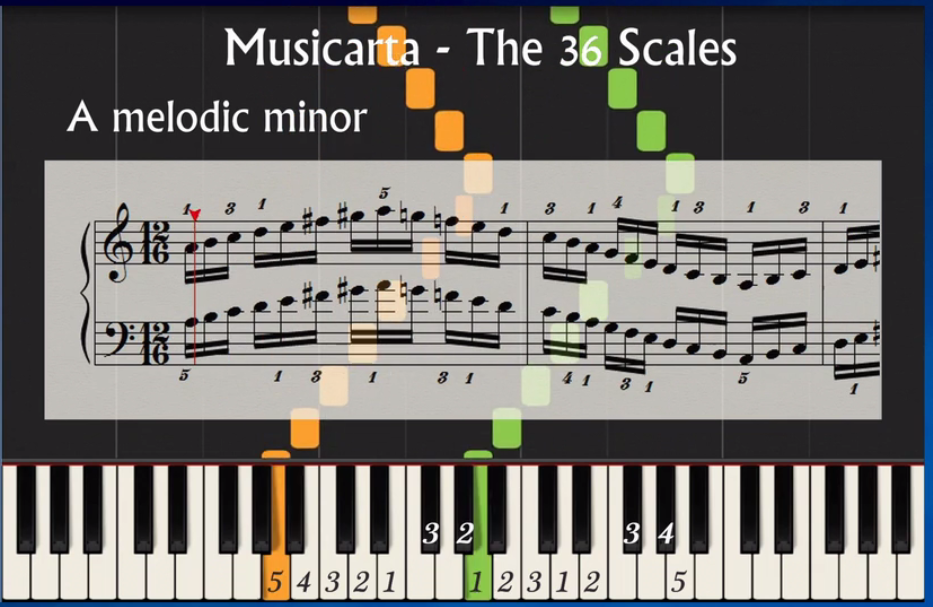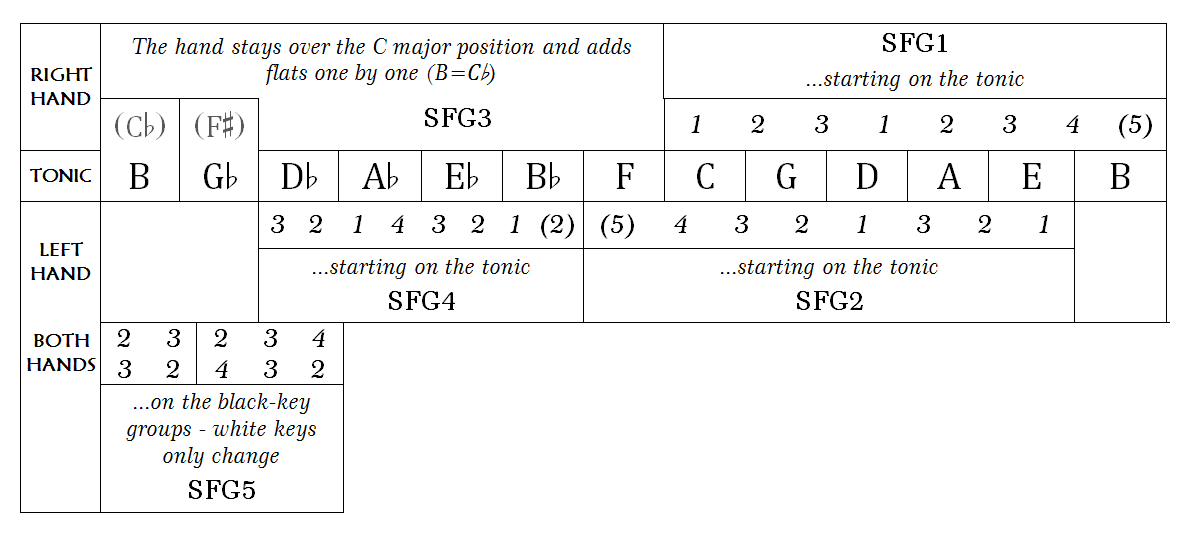Patreon ~ MUSICARTA - SCALES ~ Premium
Scales Home Page
Why bother practicing musical scales?
There are two main reasons for learning and practicing the musical scales.
One is to practice finger dexterity (swiftness and accuracy). The other is to learn the musical keys.
All
good musicians, whether pop, jazz or classical, practice playing up and
down the notes of their instruments quickly and evenly so that they can
play the notes they want, when they want.
But practicing scales has another benefit too.
Musicarta can show you ways of learning and practicing scales efficiently, so you won’t spend hours slogging mechanically through the scales without getting what’s useful to you as a musician out of it from the word go.
If you are coming back to the piano as a re-starter, Musicarta’s new and scientific approach will show what it was you were learning in your early lessons, and help you reap the benefit of the hours you invested.
If you’re a young(ish) Musicarta fan and either really hate scales or ‘just can’t see the point’, try letting Musicarta’s fresh approach persuade you to look again. Nearly every proficient musician, popular or classical, will admit, in the end, that scale practice is an essential part of a rounded musical foundation.
Your scales work should include elements of all the following skills areas.
The 36 Scales - a visual reference
 |
 |
Now uploading to Scale City, a video glossary of all 36 major, melodic and harmonic minor scales. Great for orientation or revision.
Click through here and see how many you know/remember!
The scale fingering diagram and explanation

Classical piano pupils spend many hours learning scales for exams, and remembering the fingering of the scales is a large part of their workload.
What is not generally known or taught is that the twelve major scales fall into four distinct fingering groups. Once you understand this, you’re ‘oriented’, and working within a known bigger picture rather than learning fingering in a tedious, scale by scale, way. This is a far more efficient way of working – you end up knowing your scales more quickly and for less effort.
Click through to the Scale Fingering Groups home page for the bigger picture!
‘Key’ and key signatures
The musical octave is made up of twelve semitone steps, but the major scale (and its associated key) comprises just seven different notes – not all the available notes are used. Key signatures – the collections of sharps or flats at the start of a line of piano music tell the pianist which keys to use and which to avoid in order to play in a given key.
The well-schooled musician sees the key signature in the keyboard and is pre-programmed to play the ‘right’ notes
The new ‘Key-specific keyboards’ web page presents new and intuitive keyboard diagrams representing what the proficient musician sees in response to the twelve key signatures.
To de-mystify key signatures and give an overview of the logic behind them, the keyboards are arranged in working-through-the-sharps and working-through-the-flats order, with theory notes.
Link through to the new Key-specific keyboards page here.
Scale practice patterns: Fingering
Musicarta scale fingering practice patterns addresses known inefficiencies in learning scales head on and short-circuit hours of trial-and-error frustration.
- The first Musicarta scale fingering practice pattern shows you just exactly where the thumb turns under and the third finger passes over in the Group One (sharp key) scales.
- The second Musicarta scale practice technique shows you how to practice two-octave scales.
Teachers and self-directing pupils will both benefit from this focused solution. Try it and see how quickly it improves your scale performance and knowledge of keys.
Scale practice patterns: Contour and rhythm
Scales are often practised and played without any rhythm at all, but a rhythm provides great motivation for the player to ‘keep the notes coming'. Practice patterns with specific up-and-down contours have the same effect.
Musicarta offers a collection of Contoured scale practice patterns - in D, especially for keyboard players working through the Musicarta Canon Project. Any learner wanting to get to grips with a good intermediate key signature will find the practice invaluable.
The Rhythmic scale practice patterns page is for the intermediate-on learner who has realized that conscious, musical scale practice repays the effort a thousand-fold.
Both these modules coax the learner away from written-out scales by presenting contoured patterns as simple line diagrams to be 'realized' (in any key) by a more conscious and creative, self-directing musician.
Click through and see how Musicarta’s collection of new and challenging scale practice techniques will liven up your practice and double the benefit of time spent on scales.
Scale-tone practice patterns for improvisation
Pure scale passages almost never appear in popular music. Repeated, overlapping scale fragments are, however, a major component of soloing and melodies.
Musicarta’s collection of scale-tone practice patterns offers the improvising
musician a new approach to dexterity, and an introduction to ‘improvisation fingering’.
Pentatonic scales
Pentatonic scales are extremely useful, both for creating melodies and for improvising. Practising pentatonic scales is almost like practising music – blues and heavy metal riffs are drawn almost note for note from the pentatonic minor scale, while the pentatonic major is the rock music jamming scale par excellence.
Click through to Musicarta's Pentatonic Scales home page from anywhere on the site using the PENTATONICS tab under 'Study' on the main left-hand navbar for an overview of the Musicarta Pentatonics Workbook.
The Pentatonic Hanon 01-12-20 Series is a great intro. It's on Musicarta Patreon, and forms part of the Musicarta Pentatonics Workbook and the Musicarta Video Hanon.
Minor and modal scales
Minor scales (and keys) present distinct challenges.
There are two minor scales In the Western
classical music tradition: melodic and harmonic. The
first is used principally for melodies, and the second to generate the
chords of a minor key. Watch your Patreon messages for the forthcoming minor scales material!
A great deal of minor-feel popular music, however, is modal. Musicarta Publications has a Modes Workbook to help you get these great harmonies into your repertoire. Click through for a good look inside.
A limited overview of the modes as scales will soon appear on Musicarta Patreon.
We hope you've found your visit to Musicarta's musical scales home page helpful and interesting.
Scales are underestimated as a creative building block – particularly by pupils! But if you do no other practice than playing your scales for a few minutes every day – consciously, with attention, and in a creative way – you will have kept your artistic project ticking over at least, and banked some 'musical merit' for a later date!
|
|
Sign up for the Musicarta News! Get an overview of Musicarta in manageable monthly slices, keep up to date with new postings and get the latest discount codes. The Musicarta News - regular encouragement to learn and progress! |
|
Musicarta Patreon
SCALES SERIES
Reference
Scale fingering
Scale Practice Patterns (SPPs)
Scale-tone practice patterns (STPPs)
Chromatic Scales
Diminished Scales
|
The MusicartaA methodical approach to keyboard syncopation for
|
PUBLICATIONS
exciting keyboard
creativity courses
CHORDS 101
WORKBOOK

~HANON~
video course

Musicarta
Patreon
PENTATONICS
WORKBOOK
video course

Creative Keyboard
video course

BEAT AND RHYTHM
WORKBOOK

- Volume 1 -

12-BAR PIANO
STYLES WORKBOOK

MUSICARTA MODES
WORKBOOK

PIANO STYLE

CANON PROJECT
video course

VARIATIONS
video course


- Piano Solo -
video course

- Piano Solo -


YouTube playlists





 THE LOGO
THE LOGO
